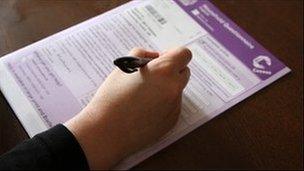Census figures: NI Protestant population continuing to decline
- Published

The last census was carried out in 2011
The latest for Northern Ireland show there has been a continuing decline in the Protestant population.
The census reveals 48% of the resident population are either Protestant or brought up Protestant, a drop of 5% from the 2001 census.
45% of the resident population are either Catholic or brought up Catholic, an increase of 1%.
7% say they either belong to another religion or none.
The highest proportions of people who neither belong to, nor have been brought up in a religion are in North Down (12%), Carrickfergus (10%) and Ards (9.4%).
One of the reasons for the decline in the Protestant population is that it is an older community with higher mortality.
Other factors include migration and the increase in the number of those who define themselves as not having any religion.
For the first time, statisticians have asked a question has been asked about national identity.
Two-fifths (40%) had a British only national identity, a quarter (25%) had Irish only and just over a fifth (21%) had a Northern Irish only national identity.
It is significant that while 45% of the population are Catholic, just 25% regard themselves as Irish only.
These figures illustrate the danger of trying to equate someone's religion with their political identity.
The population of Northern Ireland, on the day the census was carried out in March 2011, had increased by 125,600 to 1.811m, between 2001 and 2011. It represents a rise of 7.5%.
In 2011, 24% (338,544) of residents aged 16 years and over had achieved Level 4 or higher qualifications, while 29% (416,851) had no qualifications.
Almost three-fifths (59%) of people usually resident in Northern Ireland held a UK passport, just over a fifth (21%) held an Irish passport, while 19% held no passport.
The rate of population growth was greatest in Dungannon local government district (21%).
Language
The proportion of the usually resident population born outside Northern Ireland rose from 9% (151,000) in 2001 to 11% (202,000) in 2011.
The local government district with the highest proportion of people born in European Union accession countries was Dungannon (6.8%).
English was not the main language for 3.1% (54,500) of usual residents aged three years and over, almost one quarter of whom (24%) lived in Belfast local government district.
The most prevalent main language other than English was Polish at 1% (17,700 people).
Among usual residents aged three years and over, 11% had some ability in Irish in 2011 (compared to 10% in 2001), while 8.1% of people had some ability in Ulster-Scots.
- Published29 November 2012
- Published24 November 2012
- Published16 July 2012
- Published14 March 2011